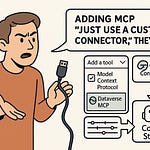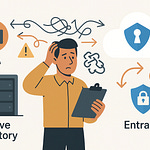Summary
Exploring Microsoft Fabric’s Digital Twin means asking: is it finally the tool that tames messy data — or just another layer of complexity? In this episode, I walk through what the Digital Twin Builder (in Fabric’s Real-Time Intelligence) promises, how it plugs into OneLake, and whether it truly simplifies modeling, mapping, and dashboards — or adds new headaches.
We’ll break down the semantic canvas, ontology modeling, mapping noisy data sources, and building real-time dashboards. You’ll see the trade-offs: how low-code aims to democratize modeling, but how dirty source data, mapping mistakes, or ontology missteps can turn the twin into a liability.
By the end, you’ll have a clearer view of when a digital twin is worth building, the kind of governance and prep work required, and whether Fabric’s version is a fix for chaos or just another project you’ll regret.
What You’ll Learn
What a digital twin really is — and why it matters
How Fabric’s Digital Twin Builder leverages OneLake, RTI, and semantic modeling
What the semantic canvas / ontology is and how it governs modeling
How to map messy sources (IoT, ERP, raw feeds) into twin structures
How Fabric supports real-time dashboards, anomaly alerts, and ML overlays
The low-code promise vs the governance burden — when it helps, when it hurts
Pitfalls and tradeoffs: dirty data, mapping chaos, evolving definitions, and scale
Full Transcript
Okay admins, you saw the title. You’re wondering: is Fabric’s Digital Twin Builder the answer to our messy data, or just another data swamp wearing lipstick? Quick fact check: it’s in preview inside Fabric’s Real-Time Intelligence, and the twin data lands in OneLake — so this plugs straight into Power BI and Fabric’s real‑time tools.
Here’s the deal. In this video, we’ll hit three things: modeling with the semantic canvas, mapping noisy data sources into a coherent twin, and building real‑time dashboards in Power BI and RTI. Cheat sheets and the checklist are at m365.show.
So before we start clicking around, let’s rewind: what even is a digital twin, and why should you care?
What Even Is a Digital Twin, and Why Should You Care?
You’ve probably heard the phrase “digital twin” tossed around in strategy decks and exec meetings. Sounds flashy, maybe even sci-fi, but the reality is much more grounded. A digital twin is just a dynamic virtual model of something in the real world—equipment, buildings, processes, or even supply chains. It’s fed by your actual data—sensors, apps, ERP tables—so the digital version updates as conditions change. The payoff? You can monitor, predict, and optimize what’s happening without waiting three days for someone to email you a stale spreadsheet.
That’s the clean definition, but in practice, building one has been brutal. The old way meant wrangling fragmented data sources that all spoke different dialects: scripts grabbing IoT feeds, half-baked ERP exports, brittle pipelines that cracked every time upstream tables shifted. It wasn’t elegant architecture; it was a glue-and-duct-tape IT project. And instead of a reliable twin, you usually ended up with a wobbly system that toppled as soon as something changed—earning you angry tickets from operations.
Take the “simple” factory conveyor example. You’d think blending sensor vibration data with ERP inventory and logistics feeds would give you a clear real-time view. Instead, you’re hit with schema mismatches, unstructured telemetry, and exports in formats older than your payroll system. ETL tools demanded rigid modeling, one bad join could choke the whole thing, and “real time” usually meant “come back next week.” That messy sprawl is why so many digital twin attempts collapsed before they delivered real ROI.
Still, companies push through because when twins work, they unlock tangible wins. Instead of making decisions on lagging snapshots, you gain predictive maintenance and operational foresight. Problems can be caught before equipment grinds to a halt, resource use can be optimized across sites, and supply chain bottlenecks can be forecast rather than reacted to. The benefits aren’t theoretical—real organizations have shown it works. For example, CSX used an ontology-based twin model to unify locomotive data with route attributes. That allowed them to predict fuel burn far more accurately, saving money and improving scheduling. That’s the kind of outcome that convinces leadership twins aren’t just another IT toy.
The trouble has always been the build. Old-school pipelines were fragile—you spent more time fixing ETL failures than delivering insight. One update upstream and suddenly your twin was stale, your dashboards contradicted each other, and no one trusted the numbers. That was the real root cause of “multiple source of truth” disasters: not bad KPIs, just bad plumbing.
Microsoft Fabric’s Digital Twin Builder is Microsoft’s attempt to break that cycle. By unifying models directly in OneLake and layering an ontology on top, it gives you a structured way to harmonize messy sources. In plain English, it’s like swapping out your drawer of mismatched dongles and adapters for a single USB-C hub. Instead of custom wiring every new data feed, you connect it once and it plugs into the twin model cleanly. It doesn’t remove every headache—you’ll still find some malformed CSVs at the bottom of the pile—but it reduces the chaos enough to move from constant repair mode to actual operations.
And here’s a key point: this isn’t just about making it work for data engineers with three PhDs. Fabric’s twin builder explicitly democratizes and scales twin scenarios. The tooling is designed with low-code and no-code approaches in mind—modeling, mapping, relationships, and extensions are all provided in a way that subject matter experts can engage directly. That doesn’t mean admins throw away their SQL, but it does mean fewer scenarios where IT is the choke point and more cases where operators or analysts can extend the model themselves.
So why should you care? Because a robust digital twin equates to fewer late-night tickets, cleaner insights, and actual alignment between operations, finance, and IT. When one system of truth lives in OneLake and updates in real time, arguments across departments drop. Dashboards reflect reality, not guesswork. For admins and operators, that’s less firefighting and more control over the environment you’re supposed to be governing.
Bottom line: digital twins aren’t slideware anymore. They can be a unifying layer that trims waste, cuts outages, and bridges the data silos that make your work miserable. The fact they’ve been historically hard to build doesn’t erase their real value—it just means the “how” has been the bottleneck. Fabric is Microsoft’s bet that low-code tools can finally make this practical, at least for more organizations.
So Microsoft says: low-code. But does that actually save admins time? Let’s test the promise.
Low-Code or Low-Patience? The Promise and the Catch
Fabric’s Digital Twin Builder puts its cards on the table with the “semantic canvas.” That’s the visual drag‑and‑drop surface where you define entities, their types, and specific instances, then wire them up with relationships. Namespaces, types, instances — it’s how Microsoft docs describe it, and that’s what you actually see on screen. The aim here is straightforward: cut down engineering friction so subject‑matter experts can participate in modeling without waiting two weeks for IT to hack together joins. Microsoft and even InfoWorld both frame this as a low‑code experience — but let’s be clear. You still need to understand your data sources and do some mapping prep before the canvas makes sense. This is not a “press button, twin built” fairytale.
If you’ve suffered through low‑code tools before, your reflex is probably suspicion. “Drag‑and‑drop” often morphs into click‑and‑regret — endless diagrams, broken undo functions, and more mouse miles than a Fortnite session. We’ve seen tools where moving one shape snapped the whole screen into spaghetti. Here’s the difference: the semantic canvas enforces consistent structure. Every relationship you draw locks into the defined ontology, killing the bad habit of ad‑hoc columns or “creative” field naming. It’s less paint‑by‑numbers, more guardrails that keep contributors from turning your data into chaos.
Picture this through the lens of a frontline engineer who couldn’t write a JOIN if their job depended on it. In the old model, pulling them into a twin project meant feeding requirements to IT, then waiting while pipelines choked and broke. In the Fabric builder, that engineer can open a workspace, drop in “Pump #12,” link it to “Sensor Vibration A,” and then tie that chain back to maintenance schedules in ERP. They’re not coding queries — they’re connecting dots. And because it all sits inside an ontology, their sketch isn’t random art that dies next upgrade; it’s a structure that admins can actually trust long‑term.
The payoff isn’t just toy demos. SPIE, for example, used Twin Builder to unify property data across its real estate portfolio. Instead of different offices juggling isolated asset systems and spreadsheets, everything dropped into one consistent model. That shift gave them portfolio‑wide, near real‑time insights into what was happening across properties, without resorting to custom regional exports. That’s not marketing‑deck theory — that’s an operations team cutting noise and getting clarity.
Now, admin honesty time. This is still “low‑code,” not “no‑work.” Messy inputs don’t magically fix themselves. If your IoT feed is spewing null values or your HR tables are riddled with free‑text “departments” (hello, “IT‑ish”), you’re just feeding the canvas garbage. The builder won’t transform broken signals into gold. What it does is give you structured, reusable building blocks once you’ve cleaned the sources. No more building the same relationship map five different times for five different twins. One model, reused everywhere. That’s a meaningful cut in repetitive cleanup cycles.
So where does this leave admins? Somewhere between “life‑changing” and “GUI purgatory.” The Digital Twin Builder won’t make non‑technical staff into SQL wizards, but it will let domain experts model their world without opening service tickets every ten minutes. For the data team, that means fewer nights wasted merging CSVs for the hundredth time. And for admins, it means guardrails that hold shape while you scale, instead of every department inventing their own naming scheme like it’s SharePoint 2010 all over again.
Upfront work still matters — you need to know your sources, and you need governance discipline — but the canvas gives you reusable blocks that drastically reduce integration fatigue. That leads neatly to the next piece of the puzzle, because once you’re building inside the canvas, you run headfirst into the concept that makes or breaks the whole thing: ontology.
Mastering the Semantic Canvas Without Losing Your Sanity
When you step onto the semantic canvas, the first thing you have to deal with is structure. Fabric forces you to describe your world using three building blocks: namespaces, types, and instances. This is the “hierarchical ontology” Microsoft loves to mention, and it’s the part that actually keeps your twin useful instead of turning into a pile of sticky notes. Namespaces are the top categories, like “factory,” “building,” or “fleet.” Types sit inside those namespaces, like “pump,” “conveyor,” or “employee.” And then instances are the real‑world things you’re tracking: Pump #12, Conveyor Line A, or yes, Bob who keeps tripping the safety sensor. The canvas enforces that order, and you apply it everywhere, so “temperature” doesn’t mean six different things depending on who imported the data.
That’s the practical angle. A lot of admins hear “ontology” and recoil, picturing academic diagrams full of bubbles and arrows no one remembers by the next meeting. But in Fabric, think simpler. It’s labeling boxes in your garage so you can actually find the wrench instead of digging every time. Nobody’s grading you on philosophy here. The only goal is consistency so your teams don’t reinvent definitions each time a new project spins up.
This structured layer isn’t just a filing cabinet, either. The ontology maps both metadata and relationships across data types so analytics can use consistent definitions every time. That means ERP, IoT, and HR data suddenly align. No more juggling three dialects where one feed says “asset_id,” another says “machine_id,” and HR just casually labels it “workstation.” The semantic canvas gives all of them one dictionary. Once that dictionary exists, your analytics and dashboards quit arguing and actually align on the same objects.
The benefit shows quickly when new signals pour in. Without a structure, every new feed means messy joins and hours of trial‑and‑error. With an ontology, Fabric just slots data into the right namespace, type, and instance. Add another temperature sensor, and it files under the pump you already modeled. Add another employee, and it slides under the same type you defined before. It’s like writing an index once, then letting every new chapter drop neatly into place without you standing watch.
Collaboration also stops being an accident waiting to happen. Left unchecked, every team will build its own flavor of “motor” or “pump.” You’ll end up reconciling dozens of overlapping definitions that all mean almost the same thing — but not quite. Fabric’s semantic canvas shuts that down. One definition per type. Everyone inherits the same design. That’s guardrails, not handcuffs, and it keeps the zoo of data at least somewhat tamed.
Of course, it’s not magic. You still need subject‑matter experts at the start to define the vocabulary. Fabric expects you to know — or be able to discover — the real entities you care about. If you don’t have experts weighing in during setup, you risk designing a structure that looks nice on the canvas but doesn’t match reality in the field. The builder reduces friction, but it doesn’t replace domain knowledge.
That combination — reusable structure, consistent definitions, and domain‑driven vocabulary — is the sanity‑saving piece. Instead of drowning in schema mismatches and fighting over what counts as “signal_dt” versus “sensor_reading,” you’ve got a single agreed layer. The payoff for admins is hours back and fewer cross‑team food fights over mislabeled data.
Bottom line: the semantic canvas isn’t theory. It’s a practical way to create a real‑world map your organization can share, update, and trust. Once it’s there, you stop arguing about labels and start building actual insight. With the ontology in place, the next job is mapping your noisy feeds into those types and instances.
Mapping Your Data Chaos Into Something Useful
Your data chaos doesn’t politely line up—it shouts over itself. Sensor streams ticking every few seconds, ERP tables spawned in a dozen dialects, HR still sitting on some Access database dug up from 2008. In the old world, you’d spin up nightly ETL jobs, cross fingers that column formats didn’t betray you, and brace for SQL Server wheezing through millions of rows. One malformed date? Pipeline gone, ops staff angry, and you’re in triage mode by dawn.
Fabric takes a different route. Instead of hammering every source into a single rigid schema, it lands data in OneLake as-is: time-series streams, CSV dumps, ERP extracts—no pre-mangling required. On top of that raw lake, the digital twin builder applies a semantic overlay aligned with the ontology. That overlay supplies the meaning: asset_id and machine_id don’t have to merge into one column; they map against the same entity definition instead. Metadata does the harmonizing, not endless field surgery.
That small distinction matters. OneLake holds the native formats, and the ontology maps them to usable structures. You cut out half the busywork because the builder doesn’t rebuild data—it translates it. It’s more like giving each system a name tag at a party: different outfits, same introduction. Analytics then sees “This is Pump #12” rather than arguing whether the source called it “pump_id” or “asset_id.”
The payoff is easiest to see in companies already pushing production limits. CSX is a textbook case. Locomotives constantly shift between train lines, and the data behind them is messy: engine specs, route details, operational constraints. Their old database model crumbled under the churn. With Fabric’s ontology-driven mapping, they stitched those feeds into one frame—locomotive plus line attributes—leading to better fuel burn predictions and a foundation for natural language queries and even ML inputs. That’s why mapping isn’t a side chore; it’s what makes twins functional.
Of course, smart mapping doesn’t mean lazy mapping. Left alone, the layer degenerates into renaming hell. One team records “machine_temp,” the next pushes “temperature,” the third swears “coreTemp” is the truth, and soon nobody trusts the twin at all. The fix here is procedural: enforce naming and mapping hygiene early. A small mapping contract and a steward per namespace keeps order. It feels like overhead until you compare it to the nightmare of doing a retrofit governance cleanup when five dashboards already depend on conflicting fields.
Done right, mapping is what collapses scattered silos into a working mirror. Instead of managing twelve dashboards shouting conflicting metrics, you get one coherent twin that answers basic but urgent questions: Which assets are running? Which are sliding toward failure? Where is today’s bottleneck? The ontology gives the structure, but mapping gives that structure meaning. Without it, your “twin” is just a catalog. With it, you’ve got a model that tracks reality closely enough to guide actual decisions.
So the win here isn’t academic. Fabric trimming ETL overhead means you’re not burning cycles on fragile pipelines. Storing native formats in OneLake lets you ingest broadly without fear of breakage every patch cycle. The semantic overlay maps fields into something everyone can read the same way. Your data chaos doesn’t vanish, but with discipline, it becomes usable.
That’s the bridge we’ve been after: raw feeds on one side, semantic order on the other, connected without you pulling nightly firefights. And the natural question once you’ve mapped all this? Whether admins and managers can actually see it in action—on screens they trust, at the pace the business needs, not buried in exports nobody checks. And that’s where things start to move from a well-structured twin into something truly visible across the org.
Turning Twins Into Insights: Dashboards, Real-Time Streams, and AI
Digital Twin Builder isn’t just about modeling. Because it’s part of Fabric Real-Time Intelligence, the twin data you store in OneLake can feed straight into Power BI through Direct Lake and into Fabric’s real-time dashboards. That means everything you just mapped doesn’t sit quietly—it becomes something you can monitor, trend, and act on without waiting for exports or stitched-together pipelines.
Here’s the blunt test: if your VP is still glued to half-broken Excel pivots while your neat ontology hums quietly in the background, you’ve built a very expensive screensaver. A digital twin that never leaves the canvas is furniture, not a tool. The real point is lining it up with dashboards and alerts people outside IT can actually use.
That’s why the integration with Power BI and Real-Time Dashboards is the turning point. Because it’s native to OneLake, you don’t juggle connections or refresh chains—Power BI and RT dashboards see the twin data instantly. Instead of emailing PDFs full of lagging charts, you deliver live feeds leaders actually respond to.
Of course, dashboards have a history of wasting everyone’s time. They’re either late, so all you get is last week’s scrapbook, or they vomit chart spam until nobody trusts them. Fabric skips that mess by making them real-time and scoped to actual events. It’s not twelve graphs you can’t parse—it’s the single signal that matters now.
Here’s how it actually fires: an Eventstream ingests the live IoT feed, KQL queries run anomaly detection in sub-seconds, an Activator rule raises the alert, and that alert flows out into Power BI or the RT dashboard your ops team stares at all day. Conveyor vibration spikes? The alert arrives as it happens, not as a red entry in tomorrow’s post-mortem. Maintenance jumps on it early, downtime avoided.
This is anchored in Fabric’s hot/cold architecture. Hot is Eventstream plus KQL—the data path watching live signals for anything weird. Cold is Delta in OneLake—the historical twin data you rely on for context and for training models. Together, you get the “alarm bell” and the “long memory.” Old platforms usually forced you to pick one. Here, you get both, and that combination is what makes the insights credible instead of superficial.
SPIE showed the point in practice. By rolling twin data into dashboards, they connected building performance across a whole property portfolio in seconds. What used to take days now updates instantly, which means sustainability metrics and investment decisions aren’t lagging behind reality. It’s not a fluffy “faster insights” slide—it’s a team shaving days of wait into seconds.
Now, mid-roll reminder: want the step-by-step checklist? It’s in the free cheat sheet at m365.show. If you’re already sold and want the cliff notes to survive rollout, grab it there.
But dashboards are only the start. The real kicker comes from Extensions and ML. Because Fabric has native support for Data Science and AutoML models, you can layer predictions right on top of the twin. That means you don’t just alert when a machine starts failing—you flag that it’s on track to fail before it does. That’s predictive maintenance baked in, not duct-taped after the fact.
Microsoft isn’t stopping at 2D dashboards either. They’re already working with NVIDIA to link Fabric twins into Omniverse—think combining twins with 3D models and robotics data. The goal isn’t overhyped sci-fi, it’s a richer operational view: spatial simulations, sensor data mapped visually, training environments where ops can rehearse fixes without touching production.
So the rule of thumb looks like this: Dashboards confirm what’s happening now. Real-time Eventstream plus KQL gives the instant anomaly check. Extensions let you predict the next failure. And Omniverse ties it into 3D models for the future. Each layer builds so the twin isn’t ornamental—it’s functional, and eventually proactive.
Dashboards plus the hot/cold path plus ML = the twin becomes actionable, not decorative. And that leads us straight into the reality check every admin needs to hear before they strap this thing into production.
Conclusion
Here’s the bottom line on Fabric’s Digital Twin Builder: it doesn’t wave a wand and fix bad source data. What it does give you are real guardrails—structure through the semantic canvas, straight mapping into OneLake, and native outputs into Power BI and real-time dashboards. Industry users report measurable wins in predictive maintenance and operational visibility; CSX and SPIE are proof this can move from theory to production reality.
For admins, the trade-off is clear. You still need governance and domain experts, but you finally get modeling guardrails and fewer dashboard fights. See the tool, try it in preview, enforce your mappings, and you’ll get real-time visibility instead of stale reports.
Subscribe to the podcast and leave me a review—I put daily hours into this, and your support really helps. Thank you!











